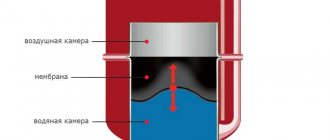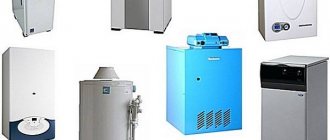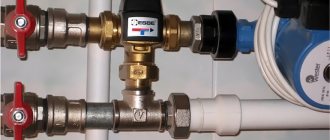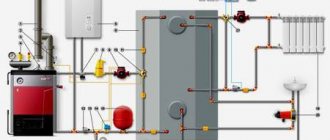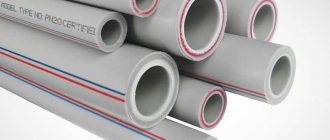Selecting a sealant
Maximum compaction when assembling sewer, heating or water supply systems can only be achieved by using a correctly selected sealant.
Two types of sealants are used to assemble pipelines:
- silicone;
- acrylic.
Silicone sealants
Silicone sealant is based on silicone rubber, to which are added:
- compositions to increase adhesion;
- compositions to increase strength;
- impurities to accelerate vulcanization.
Silicone based sealing compound
The advantages of silicone-based sealants are:
ease of use. The sealing material is applied to the surface of the pipe using a special gun or squeezed out by hand (small packages of material);
Device for easy application of sealant
- durability. Thanks to such qualities as elasticity, excellent adhesion, resistance to deformation, water resistance and heat resistance, the service life of silicone sealant is 15 - 20 years;
- wide scope of application. Silicone-based sealants can be used in the assembly of pipelines from various types of pipes. The sealing composition is suitable for the construction of internal or external pipelines, since the sealant is resistant to aggressive environments and direct exposure to sunlight.
Among the disadvantages of the sealing material are:
- seams treated with sealant cannot be coated with paint, since its composition negatively affects the sealant, reducing the service life;
- It is not recommended to use sealant when constructing a pipeline in cold weather, since low temperatures significantly reduce the vulcanization (hardening) period of the composition;
- The sealant should not be used on pipes larger than 4 inches (100 mm) in diameter.
To increase strength, silicone sealant can be used in combination with flax thread.
Silicone sealants, depending on the chemical composition, can be:
- acidic. This type of sealing compound is not suitable for sealing pipes made of non-ferrous metals, since a chemical reaction occurs between the materials;
- neutral.
Acrylic sealants
To seal water supply pipes, heating pipes, and so on, a separate type of acrylic sealant is most often used - anaerobic.
Anaerobic sealant is used to seal threaded connections. When it comes into contact with metal, the sealant hardens. The final polymerization of the substance, which imparts strength to the joint, is carried out after assembling the pipeline system assembly without access to air.
Sealing compound for threaded connections
The advantages of anaerobic sealant for heating systems, sewerage, water supply and so on are:
ease of use. The sealing compound is applied to the thread (flange connection) without the use of additional devices;
Using sealant
- resistance to vibration, which allows you to extend the service life of the threaded connection by 4 - 5 years;
- resistance to high temperatures and high pressure;
- no need to use additional sealing materials;
- additional protection of the metal surface of the thread from corrosion.
However, this type of sealant also has its disadvantages, which include:
- Can only be used on metal surfaces. For plastic pipes connected into a socket, this composition is not suitable;
- difficult to dismantle. If a specific section of the pipeline needs to be replaced, preheating will be required to separate the pipes and remove the sealant;
- the possibility of using sealant for pipes whose diameter does not exceed 8 cm;
- high price.
Depending on the strength of the resulting connection, all anaerobic sealants are divided into three groups:
- standard strength. The composition is used in the manufacture of pipelines with low pressure and not subject to vibration;
- medium strength. This sealant is used for the construction of a pipeline with average operating parameters;
- increased strength. Used to seal joints that are under high pressure and do not require constant dismantling.
For the construction of household pipelines, it is sufficient to use standard or medium strength sealants.
When choosing an anaerobic sealant, it is also worth considering the composition of the mixture and the diameter of the pipes, which may vary depending on the product line or manufacturer.
Selection of sealant according to parameters
What types of sealants are there?
All sealants for metal seams on automobile body parts can be divided into two categories - by composition and by application method. The method of application largely determines not only the ease of use, but also whether the product belongs to the professional class.
Division of sealants by composition
The mentioned products can be divided into the following five groups - acrylic, anaerobic, silicone, polyurethane, bitumen. We will describe them in the given order.
Acrylic compounds
They are based on polymer compositions. Such sealants have good adhesion, but their elasticity can be described as average. Accordingly, under strong mechanical loads and/or vibration, there is a risk that they will simply delaminate on their own and lose their properties. Accordingly, they are best used on rough surfaces (most seams are like this) and on stable mechanical components. Their strength is quite good. Acrylic sealants can be either varnished or painted.
Anaerobic sealants
Their peculiarity is that in their non-polymerized (not frozen) form they are a liquid. Accordingly, they can be poured into the smallest cracks and grooves. Their polymerization begins the moment their contact with oxygen (atmospheric air) ceases. Typically, anaerobic agents are used to seal welds in small areas or work in stages. The advantages of these compositions lie in the great strength of the resulting protective stain and its high protective properties. However, its elasticity is low. In addition, working with anaerobic sealant is not always convenient due to the fact that it spreads over an uneven surface.
What to look for when choosing?
- When heading to the store, you should already have an idea of what kind of work you need a sealing agent for. This is the first thing the seller will ask you.
- In addition, try to study in detail the instructions (it should be on the packaging) of what you will be offered.
- Determine whether the composition is for interior or exterior use.
- There must be an indication of the type of work (plumbing, roofing, etc.).
- Properties of the sealant - whether it has heat resistance or elasticity.
- Check if it suits your color.
- If there is an indication on the packaging that it belongs to the professional group, keep in mind that it is more difficult to work with, and additional knowledge of its features is required.
- Is it possible to use it in a pistol?
Steps to eliminate a leak with liquid sealant
Before you start sealing possible leaks in the heating system, you need to make sure that the expansion tank is in good condition.
The procedure for using liquid sealants to repair your home heating system can seem quite complicated. In some cases, clots of sealing fluid cause partial blockage and impede the movement of the coolant. Therefore, in order not to cause damage to the heating equipment due to your inexperience, it is better to invite a specialist. In any case, you need to study the instructions for using a specific type of sealant for radiators and strictly follow them.
Having decided to use a liquid sealant to fix a problem in the heating system, you need to make sure that:
- the reason for the pressure drop is precisely the leakage of coolant, and is not related to a malfunction of the expansion tank;
- the selected type of sealant for heating systems corresponds to the type of coolant in the system;
- The sealant is suitable for this heating boiler.
German liquid sealant BCG-24 is used to eliminate leaks in heating systems
When using liquid sealant for pipes and radiators, it is important to maintain the correct concentration. On average, its values range from 1:50 to 1:100, but it is advisable to determine the concentration more accurately, since the effectiveness of eliminating leaks can be affected by factors such as:
- coolant leak rate (up to 30 liters per day or more);
- the total volume of water in a given heating system.
If the volume does not exceed 80 liters, 1 liter of sealant will be enough to pour into the heating system. But how can we more accurately calculate the volume of water in the system? You need to calculate how many meters of pipes and what diameter were laid in the house, and then enter this data into one of the online calculators. To the resulting volume of pipelines, you must also add the passport characteristics of the volumes of all radiators and the boiler.
Preparing the heating system
- Dismantle or cut off all filters with taps so that they do not become clogged with a viscous solution of sealant for heating systems;
- Unscrew the Mayevsky valve from one radiator (the first one in the direction of coolant flow) and connect a pump to it (the “Baby” type);
- Start the heating system and let it warm up for an hour to a temperature of 50–60°C at a pressure of at least 1 bar;
- Open all taps on pipelines and radiators to allow sealant to flow freely through them;
- Remove air from the entire system, including the radiators and circulation pump.
Preparing the sealant
- You can also pour liquid sealant into the heating system using a hand pump for pressure testing.
Drain about 10 liters of hot water from the system into a large bucket, use most of it to prepare a sealant solution, and leave a few liters for subsequent flushing of the pump;
- Shake the canister (bottle) with sealant for radiators and heating pipes, then pour its contents into a bucket;
- Rinse the canister thoroughly with hot water so that all remaining sediment gets into the solution being prepared.
Solutions of sealants for heating systems must be prepared immediately before use so that the liquid does not come into contact with atmospheric air for too long.
Pouring sealant
Liquid sealant for heating systems must have time to mix with the coolant before it reaches the boiler, so it is more advisable to pour it into the supply:
- Introduce liquid sealant solution into the system using a pump;
- Pump the remaining hot water through the pump so that absolutely all of the sealant sediment gets into the system;
- Bleed the air from the system again;
- Raise the pressure to 1.2–1.5 bar and maintain the system operating cycle for 7–8 hours at a temperature of 45–60°C. This period is needed for the sealant to completely dissolve in the coolant.
Preparatory activities before filling the sealant
Before purchasing, you need to decide on the choice of sealant. The type of solution depends on the type of heating boiler and the type of coolant. Not all boilers are suitable for the same liquid sealant. Errors in choosing a sealant and improper use lead to clogging of pipe connections.
The concentration of the binder in the water of the heating system is important for stopping leaks. It depends on the volume of coolant and the amount of water loss per day; up to 80 liters of total water, 1 liter of sealant is used. The volume calculation is derived from the product of the footage of all heating pipes and their diameter. The sum of the volumes of all boilers and batteries is added to the result. These values are indicated in the technical specifications; you can clarify them by reading the device data sheet.
Advice! There is a simpler, but more time-consuming way to find out the amount of water in the system - pour the drained liquid into containers with a known volume (tanks, buckets).
Setting up the system for pouring
Air is completely removed from the pipelines. Its presence will cause a reaction and the formation of unwanted sealant clumps outside the leak areas.
All heating system valves are opened to allow free circulation and penetration of sealant into all work areas. At the first radiator along the coolant path, the Mayevsky valve is removed and a pump is installed in its place. The running system warms up to 60 degrees for about an hour. The pressure should reach 1 bar.
Before starting work, all filters must be neutralized. They are dismantled or covered. Contact with the sealing solution will clog and damage the filter.
Purpose of oven sealants
During active use of fireplaces and stoves, brickwork may crack. The risk of cracks appears increases if the brickwork is not lined with tiles, protected by a layer of plaster and not covered with heat-resistant paint.
Repair work cannot be postponed - using such a fireplace or stove becomes unsafe.
Depressurization of the walls of the combustion chamber, chimney or other elements of the furnace negatively affects the operational characteristics of the device and entails a number of dangerous consequences
Possible problems caused by the appearance of through gaps:
- fuel consumption increases due to the fact that additional air leaks into the combustion chamber;
- soot appears outward from the cracks - a corresponding coating appears on the ceiling and walls; in such situations, even cleaning the chimney does not solve the problem;
- combustion products hazardous to health enter the room - there is a risk of poisoning;
- periodic extinguishing of the pilot flame - probably due to depressurization of the chimney;
- fuel burns at low temperatures, which causes more soot to settle on the walls of chimney pipes.
Depressurization of the heating system and an abundance of soot is a fire hazardous combination. Incoming oxygen provokes fire inside the chimney.
If the exhaust duct is poorly insulated, the likelihood of a fire increases significantly.
Timely sealing of cracks and gaps will help to avoid serious problems. It is clear that only heat-resistant compounds are suitable for such extreme operating conditions.
Peculiarities
Thanks to sealing compounds, the construction and renovation process becomes simple and fast. With their help, you can reliably fasten various surfaces together without nails or a hammer, use them as a sealing agent and for sealing cracks and cracks. When installing windows or troubleshooting minor problems in everyday life, they are indispensable, saving money and time. Their use allows pipes to be repaired without opening walls or removing plumbing structures.
Liquid sealant is currently stronger than glue, but not as “heavy” as mortar.
The sealing liquid has a number of properties:
- does not change its characteristics under the influence of high temperature;
- is moisture resistant;
- withstands heavy loads.
The liquid solution is one-component, comes in tubes and is ready for use. The product for larger-scale work is available in canisters of various sizes.
Scope of application
Liquid sealant can vary in its composition and scope of application:
- Universal or “liquid nails”. Can be used for both external and internal work at home. With its help, you can glue materials together (glass, ceramics, silicate surfaces, wood, textiles), it is used for various types of repair work and seals various seams. Without the use of nails, you can fix tiles, cornices, and various panels. The transparent solution provides an almost invisible connection to the eye, which is very strong and reliable: it can withstand loads of up to 50 kg.
- For plumbing. Used for sealing joints of sinks, bathtubs, showers. It is characterized by increased resistance to moisture, high temperatures and cleaning chemicals.
- For auto. Can be used when replacing gaskets, as well as in the cooling system to eliminate leaks. Before using this product, you must wear safety glasses as it may damage your eyes.
- "Liquid plastic" It is used when working with plastic products, for example, when installing windows, it is used to process joints. Thanks to the presence of PVA glue in its composition, the glued surfaces form a monolithic joint.
- "Liquid rubber". It contains liquid polyurethane, which allows it to be used in cold and damp conditions. It is a very durable sealing agent and is used in various types of repair and construction work. This product was invented in Israel; it looks like rubber, which is why it got its name. However, manufacturers prefer to call it “spray waterproofing”. The solution is excellent for applying to house roofs to fill hidden leaks in seams.
In addition, “liquid rubber” is suitable for emergency repairs when tires are punctured, filling microcracks and forming a very strong connection. This liquid can also be used for prevention in order to create a protective layer inside the wheels. This is used for vehicles that operate in extreme conditions.
Application
External treatment
So, we have become familiar with the types of compositions, now we will look at how to use radiator sealant.
The work is performed in this order:
- If it is necessary to eliminate a leak, then first of all go to find the damaged area.
- After this, you need to drain the coolant from the radiator.
- Then you need to clean the damaged area with your own hands from dust, dirt, old paintwork, etc.
- Then the composition is applied to the treated area.
- After this, you need to wait for the sealant to dry, after which it is possible to fill the system.
Internal processing
Now let's look at how polymerizing sealant for radiators is used.
This process is not much more complicated than external processing:
- Before pouring sealant into the radiator, you need to rinse it with running water.
- Then it is necessary to dismantle all filters or cut them off with taps.
- After this, you need to start the system and heat it to 50-60 degrees.
- Then you need to bleed the air space from the system, otherwise it will begin to interact with the product.
- Then you need to drain the water from the system and use it to make a solution. Along with this, several liters must be left to flush the pump.
- After this, it is necessary to remove the Mayevsky tap from the battery and connect a “Krokha” type pump instead.
- Using a pump, a solution of sealant and water is introduced into the system. If the amount of coolant in the system does not exceed 80 liters, one liter of product is sufficient. In another case, its number needs to be expanded.
- Then you need to increase the pressure in the system to 1.5 atmospheres.
- The heating system must be maintained in this mode for several hours until the product polymerizes.
- After this, you need to release the coolant, fill it with water and then drain it again. But, before flushing the radiator after finishing the sealant, make sure that the leak has been completely eliminated.
This completes the process of eliminating radiator cracks.
How to choose
It is important not just to choose a sealant for the radiator, but also heat-resistant options to eliminate leaks. If you notice that a joint is leaking somewhere near the batteries, you need to decide which sealant will help, and reviews can help in this matter. The choice of sealant is made based on the tasks it must solve to eliminate leaks in the heating system
If it will be used to seal the joints of the heating system, then paste-type silicone sealant is perfect for these cases
The choice of sealant is made based on the problems that it must solve to eliminate leaks in the heating system. If it will be used to seal the joints of the heating system, then paste-type silicone sealant is perfect for these cases.
It can be drying or non-drying version.
Differences between sealants may include the following:
- Drying compounds. After the composition applied to the surface dries, it has the ability to shrink, but this happens if the drying technology is broken. Thus, deformation of the composition may occur, cracks and drips may appear.
- Non-drying compounds. Ideal for removing small cracks and can also be used to seal heating system joints. But such compounds can be squeezed out if the pressure in the system exceeds the normal value.
Aerobic-based compounds, which are considered a type of acrylic sealants, are used in some situations to eliminate defects and leaks in heating systems. This type of sealant is able to withstand temperature changes, is resistant to mechanical stress and is resistant to alkali and acid solutions. If you apply it to the site of a defect, it quickly fills the defect and dries.
Sealing of threaded connections
H2_2
Liquid sealants for such purposes are made on a silicone basis. They have a good reserve of heat resistance and facilitate the installation of heating connections due to their lubricating properties. A threaded joint with such a sealant is easy to disassemble, compared to flax tow or FUM tape. Connection solutions are divided into two categories:
- Drying sealants. When the solution dries, it shrinks and there is a risk of cracks and leaks;
- Not drying out. They are well suited for eliminating leaks, making it easier to disassemble threaded connections, but under strong pressure they are squeezed out of the joints.
Anaerobic sealants
A separate group is represented by anaerobic sealant. Resistance to temperature fluctuations, mechanical stress, and good leak neutralization made it possible to use an anaerobic solution even in rocket science. In heating systems, the main advantage is the substance’s resistance to compounds containing acid and alkali. Thanks to this property, the anaerobic sealant in the system does not interfere with cleaning with chemical compounds and the use of various coolants.
In the liquid state, an anaerobic solution exists only in the presence of air. Finding itself in a closed place between the parts, it easily fills all the remaining free space and quickly hardens. The latter quality gives reliable threaded fixation and eliminates the need for great physical effort when screwing parts.
Important! The rigid adhesion created by the anaerobic solution is a serious obstacle when dismantling heating structures. Disassembling the clamps will require good warming up, as well as the use of additional tools.
What to rely on when choosing
To eliminate leaks in a heating pipe, almost any sealants (acrylic, silicone, etc.) are used.
When choosing the optimal substance, pay attention to price, temperature conditions, resistance to water and mechanical deformation. And also remember some subtleties:. And also remember some subtleties:
And also remember some subtleties:
- If the heating installation is not located in the house, then it is advisable not to use acrylic sealant, since it does not tolerate water and mechanical damage (for example: if water gets into a crack during prolonged rain, this will lead to cracking of the substance).
- Acrylic sealant is also not recommended for use when a powerful heating boiler is installed, as the product can crack at very high temperatures. It is better to give preference to heat-resistant silicone and thiokol mixtures.
- To seal threaded connections, it is recommended to use silicone and thiokol sealants, since after hardening they do not deform and do not clog the thread.
Reference. In everyday life, it is recommended to use silicone sealant to solve most problems, as it has good performance characteristics and a low price.
Effectiveness of sealants against leaks
Sealants are good connectors for sealing leaks in pipes. Experienced engineers claim that if the sealing rules are followed, it is possible to seal cracks with sealant in 90% of cases. However, the use of the product must be justified from an economic and engineering point of view. For example, if you know the location of the crack and have access to it, then it is recommended to repair it by welding.
Another example: a leak occurred due to the formation of a large hole in the system - in this case, the use of sealant is inappropriate, since it only seals small cracks.
Old methods of compaction
There are three main types of sealant based on their intended purpose. The first type is for sealing pipe joints. The second is for external use, used for repairing pipes. The third is sealing compounds for pouring into the heating system. This is more than enough for our review.
Many of us remember that previously no sealant was used for heating. Its role was played by the FUM tape, which is still in service. It is a fluoroplastic film, highly stretchable and capable of sealing pipelines for various purposes. It is used when installing heating systems and is used when laying water pipes. When wound around a threaded connection, it provides excellent tightness.
Instead of fluoroplastic sealing material, synthetic flax is often used. This is a thin flexible thread of more universal use - it is suitable for gas pipelines, water pipes and water heating systems. Many experts, choosing between FUM tape and flax, opt for the latter.
Choosing a universal and heat-resistant sealant for heating pipes
A situation with a leaking heating circuit is not uncommon, since the heating system consists of many components and elements, the tightness of their connection with each other is sooner or later broken. In addition to joints, a depressurization zone can also be an entire span of pipe that is physically worn out or damaged due to the influence of some factor.
Sealant for heating pipes, available in different types and designs, helps solve the problem of a leak or ensure long-term tightness of the connections of its elements during installation of the system.
Types of sealants for heating systems
Different manufacturers offer a large selection of sealants that differ in their chemical composition and purpose. They are conventionally divided into the following groups:
- silicone;
- polyurethane;
- liquid polymer.
Each of them has its own purpose and properties.
Silicone sealants
Silicone is the most popular. With its help you can seal any joints and eliminate leaks. Withstands temperature changes ranging from 30 to 60 degrees. The composition has all the necessary qualities to perform high-quality work:
- strength;
- penetrates into the most inaccessible places;
- elastic.
When purchasing, pay attention to the composition of the silicone sealant. The acid contained in some types can cause metal corrosion
Universal silicone sealant
Polyurethane
They belong to the group of oligomers. In addition to polyurethane compounds, there are also polysulfide compounds. Both types are widely used in construction. To seal heating systems, carefully study the composition, since not all materials are suitable for these purposes.
A distinctive feature of polyurethane sealants is durability, resistance to aggressive environments and mechanical stress. In addition, material consumption is very economical.
Polyurethane sealants come in one- and two-component types. The former are cheaper, but take longer to harden. They have good elasticity, adhesion to metal, resistance to high temperatures and corrosion. However, despite many positive qualities, polyurethane sealants are not as in demand for household purposes as silicone ones due to their high price.
One-component polyurethane sealant
Liquid sealant for heating system
Liquid-type sealants are used where there is no easy access to the leak or it is simply not visible. The principle of operation of the polymer liquid material is based on the fact that it is poured into the system along with the coolant. In the section of the pipeline where there is a leak, the composition, interacting with air, begins to polymerize. Thus, thickening, it seals the cracks.
The following types of liquid sealants are distinguished:
- for systems installed in water;
- for heating systems running on antifreeze;
- for troubleshooting metal surfaces;
- for plastic pipes.
This variety allows you to choose a sealant to suit your individual needs, so carefully read the instructions before purchasing.
Liquid sealant for heating system
Types of liquid sealants, their advantages and disadvantages
Liquid sealants can be classified according to their composition:
- Acrylic. Unresistant to temperature changes;
- Polyurethane. They are plastic, have good adhesion to metals, are not afraid of rust and temperature changes;
- Silicone. They do not lose elasticity and water resistance in heat and cold, are durable and versatile.
Fact! Silicone sealant, which contains acetic acid, is not suitable for working with metal parts. The acid will cause a rapid corrosion process.
Primary requirements
Sealant for heating radiators can be useful not only during the installation of the latter, but also during repairs, for example, when the batteries are disassembled into sections or a leak appears in them. The use of this substance will guarantee the tightness of all joints, which will not be broken even after heating is completed.
It should be emphasized that there is currently a wide range of different types of sealants on the market, which are intended for various purposes. Needless to say, this pairing makes the choice difficult.
Based on this, in order not to make a mistake, you should first of all decide on the basic requirements that a given substance must meet.
So, taking into account the conditions under which the sealant will be used, it is possible to come to the conclusion that it must have the following qualities:
- Heat resistance;
- Resistance to deformation;
- Moisture resistance;
- Resistant to temperature changes.
Below we will consider which specific types of sealants meet these requirements.
Sealant pouring process
A bucket of hot coolant is poured into a pre-prepared container. Another half bucket is taken separately for subsequent washing of the container, in order to get all the components into the heating system. The sealing compound is shaken and added to the bucket of drained liquid. The solution should not be in contact with open air for a long time, so it is immediately pumped into the system. The procedure for removing air from the pipes is repeated.
To distribute the sealing composition throughout the heating fluid, temperatures up to 60 °C and pressure up to 1.5 bar are maintained for several hours. The seal is created by polymerizing the sealant. This process takes 3–4 days of continuous operation of the heating system. On the fifth day, the pressure and leaks are checked.
Characteristic signs of a properly functioning heating system are that the house is always warm, stable coolant pressure in the circuit, and no leaks. Reliability is laid down at the installation stage, which depends on the skills and qualifications of the installer. But sometimes leaks do happen, causing users a lot of problems. Let's see how to get rid of leaks and achieve a tight system even at the stage of its construction.
- What is the best way to seal pipe joints?
- How to get rid of a visible leak.
- How to get rid of a hidden leak.
We will provide detailed instructions for each question.
Pros and cons of using liquid polymer materials in plumbing
Manufacturers claim that anaerobic sealants are an ideal material with no disadvantages. However, professional craftsmen were able to discover several minor disadvantages during use.
| Advantages | Flaws |
| The compound does not lose its properties at temperatures in the range of -196º, -60º to 150-300ºС. High resistance to mechanical and dynamic loads. Economical material consumption. Neutrality to aggressive environments and vibrations. After hardening, it does not dissolve in water. Possibility of reliable connection of materials of different structures. Resistance to high pressure: about 50 atmospheres and above. | Dependence on low temperatures - hardening time increases. Limited use - not recommended for sealing pipes with a diameter of M80 and above. Sensitivity to moisture - applied only to dry surfaces. They provide strong fixation and are therefore suitable only for permanent connections. |
Some installers express dissatisfaction with the high cost of products. However, the price seems quite justified, given the quality and economical consumption of the composition.
3
Types of compounds - what are the means for fixing compounds?
To be able to use the composition when installing different degrees of complexity, there are several types of sealants on the market. The main difference between them is their viscosity, fluidity and ability to penetrate into the thinnest crevices. In addition, the product can be intended not only for sealing threaded connections, but also for fixing fittings, flanges and bushings. On the container of the composition there are always tables and instructions with the help of which it will be possible to determine the suitable areas of its use.
Depending on the degree of strength, sealants are divided into three types: standard, medium and high strength compositions. Products of the first category are used to work with connections that, as a rule, are not subject to vibration. These compounds are also used in cases where pipes need to be dismantled frequently. The stall power of such devices ranges from 4–9 Nm. This allows you to remove hardened sealant without the use of special tools.
Waterproofing with anaerobic sealant
Medium strength compounds are used in service and repair work to secure connections exposed to vibration or high pressure. In such sealants, the breaking power ranges from 15 to 22 Nm. Dismantling of this type of product requires the use of tools or heating with fire. Third class sealants are used for threaded connections that are not planned to be removed in the next few years. Such products can withstand the strongest vibrations and very high pressure. To break a connection treated with such a sealant, a force of at least 55 Nm is required.
Description of material
Sealant Abris S-LTpvkh 50x1 is a black polymer-bitumen tape reinforced with polyvinyl chloride film. Available in the form of tape in rolls. Has good adhesion to metal, plastic and other materials.
When installing a new heating system, changing batteries or re-sealing threaded connections in the heating system before the start of the heating season, spend a couple of minutes of your attention on what materials the specialist will use in his work and what he will use to seal, for example, the pipe leading to the heating system of your Houses. Why is it important?
Linen is a biodegradable, short-lived material. We can all remember with affection the “grandfather’s” cast iron batteries that stood for 50 years, but today the operating conditions of the systems have radically changed. Replacement of such sealant for heating batteries will be required after 3-4 years.
There are many sealants for batteries and pipes of heating systems, belonging to different generations of thread sealants and having different applications (for more information on the classification of high-temperature anaerobic sealants, see the video). Flax is traditionally used in sealing heating pipes, when people ask the question “what is the best way to wrap heating pipes?” But what was good 30 years ago, in modern conditions is a manifestation of a low level of professionalism.
What basis is there for this statement?
Firstly: modern paints have a different composition, different from that which was characteristic of the samples of the Soviet period. They are completely unsuitable as impregnation for linen thread. Silicone is even less suitable for this purpose. The vinegar it contains leads to corrosion of the threads of heating pipes. As a result, rust occurs within the first months of using such a seal. Such sealants are especially not recommended for use on heating radiators and other similar heating systems.
Secondly: multi-storey new buildings are no longer Khrushchev’s five-story buildings. When pressing the heating pipes of a multi-storey building, a pressure exceeding the permissible 8 atmospheres for flax is applied. Therefore, in such cases it is contraindicated to use this sealant for heating joints.
Modern multi-storey construction involves the operation of internal highways at pressures of up to 16 atm.
As a result, the connections on the flax either burst when the flax swells, or do not withstand the operating pressures at which the heating pipe system is operated. If there are only a few such connections in your apartment, then this is still tolerable. But what about individual cottages in which the number of threaded connections reaches several hundred? Are you ready to withstand the invasion of plumbers into your home every 3-5 years? And can you be sure that none of the several hundred connections will leak or burst under pressure? Of course not! Therefore, we do not recommend using such sealants for threaded heating connections.
Another option for sealing threaded connections, which we do not recommend using for heating systems, is Fum tape. Supporters of FUM tape highlight its simple use - unlike flax, there is no need to use third-party materials to use it, it is easy to wind on a fitting, which is why it is still on the market. However, it is worth keeping in mind a number of disadvantages of using fum tape.
Among them:
Firstly, choosing a high-quality FUM tape is not easy. It should not tear or crumble. The correct FUM tape is elastic, it stretches easily and does not break into fibers. If you use low-quality material, then after a short period of time a leak cannot be avoided.
Secondly, such a material cannot withstand multidirectional loads that arise during thermal linear expansion and contraction of pipelines during cooling. Therefore, fum tape can only be used in cold pipeline systems.
Heating leak Liquid sealant will help eliminate the leak
German liquid sealant from BaCoGa Technik.
Fixing a heating leak is an unpleasant thing. If we are talking about a hidden leak in the heating system, then doubly so. There are many reasons why heating leaks occur. This is corrosion when a steel pipe heating system leaks. These are low-quality fitting materials, which over time begin to leak coolant at the points of contact between different materials. Heating pipe and system leaks may appear in places where plastic pipes were welded unprofessionally. A heating pipe leak in a “warm floor” can occur if plastic pipes are primitively poured into concrete without compensating for expansion when heated. Even gaskets that have dried out at the joints cause heating system pipes to leak.
Yes, heating system leaks are a problem. But a hidden leak in a heating pipe is simply a tragedy.
It’s one thing when a fitting or pipe drips in front of the owner of the house. Elimination of heating system leaks can be achieved using one of many known methods. Elastic linings and bandaging with special tapes, both “cold welding” and hot welding will help eliminate heating pipe leaks, and finally, eliminating heating pipe leaks can be achieved by replacing a section of a defective pipe or fitting. A plumber will handle the repair of heating system leaks.
It’s another matter when the pressure sensor shows that the coolant is leaving, but leaking heating pipes cannot be detected and eliminated. If a wet spot appears on the wall or floor, it means you are lucky. It is expensive and troublesome to open parquet and concrete, cut out a piece of a defective pipe and fix a heating system leak. But at least it is clear how the heating pipe leak was eliminated.
What if nothing is visible? Resourceful Russian craftsmen drain the water, pump air into the heating system pipes and crawl with a medical stethoscope, hoping to hear the hiss of air under the parquet in the place where the heating pipes and heating system are leaking. Doesn't help fix the leak! Verified. You can call an expensive team with a thermal imager to try to find leaking heating pipes. Cases of success are rare.
— How to add BCG to the system?
Remove dirt filters before completing repairs. The system must be filled with coolant. Shake the sealant until the sediment is completely mixed.
Pour BCG into a pump container and dilute with water. Connect the system and pump with a hose and clamps. Open the valve and pump sealant into the system.
Close the valve, disconnect and flush the pump. Turn on the system in normal operating mode. The leak is eliminated within 1 to 7 days.
For such hopeless situations, when it is difficult to find and repair leaking heating pipes, BCG liquid sealant was created in Germany four decades ago.
How are similar problems solved in Germany? A team called to fix a heating leak offers the cottage owner two options. The first involves breaking into floors and walls. Fixing leaking heating pipes is expensive, dirty and takes a long time. And the second one is simpler, cheaper, cleaner and faster using BCG liquid sealant.
The goal is to eliminate the leak in the heating system.
The use of liquid sealant does not provide a 100% guarantee of success, since the reason why the heating pipe leaked is unclear, and the location of the leak is hidden. Rarely, there is a heating pipe leak that a liquid sealant cannot eliminate.
Here are some cases that we have encountered in our practice:
Fortunately, such cases are rare. More than 1000 repairs in Russia have been completed successfully. Thanks to the sealant we provided, the heating leak was eliminated. And in Europe, over the course of several decades, this number has exceeded one hundred thousand. If the nature of the heating system leak, the amount of coolant loss, and other factors correspond to the capabilities of the sealant described in the instructions, then eliminating the heating leak will be successful. The owner of the house will forget for a long time, if not forever, what a leaking heating system and leaking heating pipes mean.



